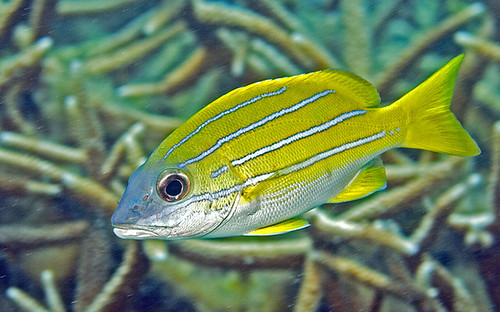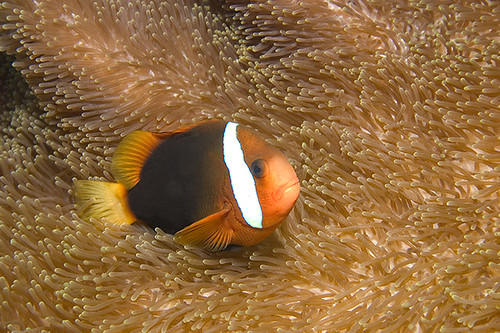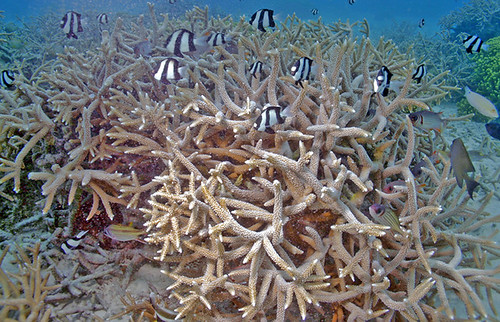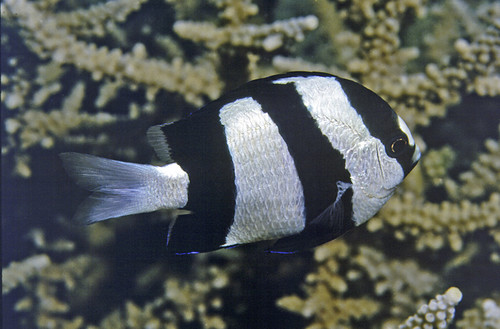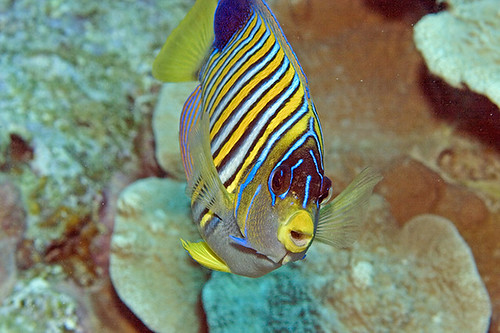Coral Reef Fish of Guam
Many roles to play
Marine fishes fulfill several important functions for Guam. Traditionally, fishing on coral reefs has been an important part of local CHamoru culture, and fish were valued as an important food source. While dependence on the fishery has decreased, these resources remain culturally important today. The bright colors and interesting behaviors of fishes provide attractions for snorkelers and scuba divers, and help support Guam’s tourism industry, a major part of Guam’s modern-day economy. Fish play important roles in the ecology of coral reefs, and indeed are critical for the health of coral reefs.
Diversity and systematics
Nearly 100 families of fishes, and more than 880 fish species, occur on the coral reefs of Guam. Compare this to Hawai’i, which “only” has around 600 species. About half of Guam’s species are contained within 10 species-rich families. These include the gobies, wrasses, damselfish, snappers, blennies, cardinalfish, butterflyfish, surgeonfish, moray eels, and pipefish.
Fishes inhabiting the reefs of Guam can be divided into two large taxonomic groups, the Chondrichthyes (the cartilaginous sharks and rays) and the Osteichthyes (the bony fishes). This article will focus on the bony fishes.
Bio-geography
Guam is in part of the world known by bio-geographers as the Indo-West Pacific, which includes the western Pacific Ocean as well as the Indian Ocean. This large area is the most species-rich marine faunal region in the world and the species composition of the reef fish fauna of Guam is similar to that of other islands and reefs in the western Pacific and Indian Oceans.
It is presumed that, with the exception of a few endemic species, the fish species found on Guam originally arrived from other places. New fish species could travel to Guam by drifting on the currents while eggs and larvae, by associating with floating debris drifting in the ocean or, in more recent times, by traveling in ballast water in ships and barges. There have been no successful intentional introductions of marine fishes to Guam’s waters.
Some species of reef fish are endemic to (only found in) the Mariana Islands. Among these are the Guam damsel, Pomachromis guamensis, and the Yellow-crowned butterflyfish, Chaetodon flavocoronatus.
Fish habitats on the coral reef
Coral reef growth is limited by how much sunlight the coral animals can receive. Generally, coral reef growth is limited to about two hundred feet in depth. Thus, most coral reef fiash fishes are found within this depth range. Coral reefs can grow in a variety of forms, depending upon several variables, including current, amount of sunlight, and proximity to the nearest land mass.
Reefs around Guam fall into one of two types; barrier reefs and fringing reefs. There are two barrier reef lagoons on Guam, Cocos Lagoon to the south and Apra Harbor on the west. Most of the rest of the island is edged by fringing reefs. These reefs and lagoons provide a variety of habitats for reef fishes.
In general, the number of fish species is greatest in areas with more rugged and variable topography than in flat areas of sand or reef rock. Also fish diversity is usually greatest in shallow reef areas and declines with increasing depths. Many coral reef fishes are rarely found below two hundred feet deep.
Activity and feeding habits of reef fishes
There is a great diversity of food habits among reef fishes, which helps to account for the coexistence of so many species on Guam reefs. On reefs, you can find fish that eat other fish, algae, corals, crabs, sea urchins, and many other items as well.
The majority of reef fish species are active during the daylight hours, and they retreat into sheltered locations at night. Several of these species exhibit nighttime color patterns that differ from their patterns during the day. A few fish groups, including squirrelfishes and cardinalfishes, are more active at night, and several predatory fishes, such as snappers and groupers, are more active during the twilight periods at dawn and dusk.
Color patterns
One of the most conspicuous features of fishes living on coral reefs is their bright color patterns. While some fishes, especially small blennies and gobies, have rather drab color patterns, which camouflage them, others, such as butterflyfishes, angelfishes, damselfishes, and parrotfishes, have bright colors and bold patterns that make them very visible on the reef.
Several theories have been proposed to explain why such color patterns, which would seem to expose fish to greater risk of detection by predators, should be common. Reef fish color patterns are largely species-specific, and so it seems likely that a fish can use color patterns to recognize other members of its own species, and, it is quite likely that small, individual variations in color patterns allow a fish to recognize other fish as individuals.
In some species, males and females differ in their color patterns, and so sexual recognition also plays a role in conspicuous reef fish coloration.
Reproductive behavior
Sexual identity is surprisingly mutable among reef fish species. While fishes in some groups, such as butterfly fishes, remain the same sex throughout their lives, in the majority of reef fish species, changing sex is common. Clownfish, for instance, first mature as males, and then, as they get older, some of the males transform into females. This usually happens when the female of a mated pair dies or disappears. Then the male of the pair changes into a functional female, and a previously immature clownfish matures to be a male.
A more common pattern is for females to change into males. This transformation is seen among many species of wrasses and parrotfishes. The usual social unit in these species is a group of fish consisting of a single colorful, dominant male and a group of less colorful females with which he mates. If this male should die or disappear, the dominant female in the harem will change sex and color pattern and become the dominant male of the group.
Mating in reef fishes involve external fertilization of the eggs by sperm. In some species, such as damselfishes, blennies, and triggerfishes, the eggs are deposited on the reef where they are fertilized and, subsequently, cared for by one or both parents. In most of the rest of the species, eggs and sperm are released freely in the water, where fertilization occurs, and then the fertilized eggs float off to develop and hatch on their own. A few groups show specialized parental care of the eggs. For example, male pipefishes brood their fertilized eggs in an abdominal pouch; cardinal fish males brood the fertilized eggs in their mouth.
The larvae of almost all reef fishes are pelagic and float or swim in the open waters until they grow and develop to the point of settling down on the reef. During this pelagic stage, most larvae die and some may drift considerable distances before settlement.
Reef fish have been, and continue to be, an important marine resource for the people of Guam.
For further reading
Amesbury, Steven S., and Robert F. Myers. Guide to the Coastal Resources of Guam, Vol. 1: The Fishes. Mangilao: University of Guam Press, 1982.
Myers, Robert F. Micronesian Reef Fishes: A Comprehensive Guide to the Coral Reef Fishes of Micronesia. 3rd ed. Barrigada: Coral Graphics, 1999.
